For an Art Studio Is Light Best From the North South East or West
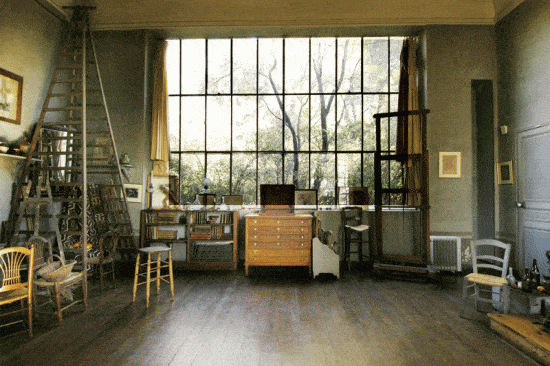
Natural calorie-free in Cezanne's artist studio
Have you ever been half-fashion through a painting and of a sudden the art studio light changes?
You bear on painting, hoping for a break in the weather, trying to remember the colour you've just mixed, and so the lighting changes.. again.
You think it won't matter, it's non that important, but the way you light your fine art studio can exist 1 of the most cost effective ways of improving your painting and your colour mixing without buying another tube of pigment.
One of the easiest methods of designing better lighting, is to only change your lite seedling.
Simply non all studio lamps are created equal.
From a £5 hardware store fluorescent tube to a £i,500 bespoke solution, the choices you make touch on your ability to match colours accurately, judge skin tones effectively, and fifty-fifty feel a petty happier past the quality of low-cal you paint within.
With different options bachelor you can have studio lighting the Former Masters would have been proud of…. without turning to shots of Absinthe.
Emergency chocolate biscuits needed
Trying to empathise all the considerations when choosing my own studio lighting most led me to a lighting cook downwards! Only acquit in heed, I'one thousand trying to design a bespoke studio where I'll be painting 12 hours a solar day some days, through gloomy British weather condition and many a midnight painting session. So I need a space that has both natural light and the best quality artificial calorie-free.
At that place are and then many variables and it's such a specialist request that many Electrician'due south will roll their eyes at you. With this catchy subject in mind, I have tried to created a summary of what you actually need to know, and information technology tin can get a bit technical in places.
Exercise I really need to know this? I hear you cry!
Maybe, maybe non.
It depends on how much painting you exercise and your current lighting situation…
Artist studio lighting
Every bit a painter I accept worked in a range of studios with a variety of lighting, from the nigh fantastic natural brightness of light in the Mediterranean to orange incandescent bulbs that made my paintings look dull and dreary.
Finding a solution between natural lighting, artificial lighting and your budget can be a balancing deed, depending on the subject you lot are lighting, your manner of painting, space you have and funds available.
I've been struggling for years to find a uncomplicated, easy solution and have had many setbacks with my paintings along the way, trying to empathize the divergence between the lighting types, styles, colour temperatures, Kelvin's, CRI's the list seems to get on!
I'one thousand currently just finishing edifice my new studio and thought it was the perfect opportunity for me to address all the art studio lighting questions I've had in the past and put them into exercise in my new studio infinite.
Picture hanging vs picture painting
Generally, the light you lot use in your studio is nearly ever going to be different to the specific lighting arrangements of where the painting will finally hang and be viewed in.
I've painted subtle grey tones before, that look fantastic on my easel, just I know from experience they would nigh disappear if hung in a hallway without natural low-cal.
I tend to paint in quite a vivid space, the same lite illumination levels yous'll normally find in an operating theatre, so when the paintings are displayed in a room with softer bulbs, the effect of the painting changes.
So, if you lot are commissioned to create a painting and have a take a chance of viewing the wall where the movie will hang, I'd say it is pretty critical to become and accept a look.
It could be a vivid conservatory or a dimly lit corridor and this tin can dramatically change how you lot approach the commission.
So what's the best light to paint in? Let's commencement with the artist favourite, Due north light.
The myth of North Light
All artists pigment under Due north light, right?
That's what we're led to believe if you could simply detect the perfect window, the right size and the perfect height, that sends in soft North light, your paintings would be…perfect?
Not quite.
N low-cal describes the location of the sunday in the sky, having a window that but allows in North light helps to avoid having direct sunlight smooth into the art studio while you work.
This is amend for a painter considering the calorie-free is more constant.
Notice how I didn't say 100% constant, but more constant than the dramatic changes that happen with direct sunlight.
Northward light withal changes.
Pro tip: Due north lite only works if your studio is in the Northern Hemisphere, as a North lit artist studio in the Southern hemisphere will face direct sunlight coming through the window.
Windows and bounced light
The first thing to look at is where your window is.
Ideally, you would want a North facing window above your easel at virtually 35° angle from your canvas, so you get directional light on the canvas without getting glare.
Glare is well-nigh prominent if you are painting vertically with oil paints.

Photo: Perry Ogden, Francis Bacon's studio – discover the position of the easel in relationship to the window
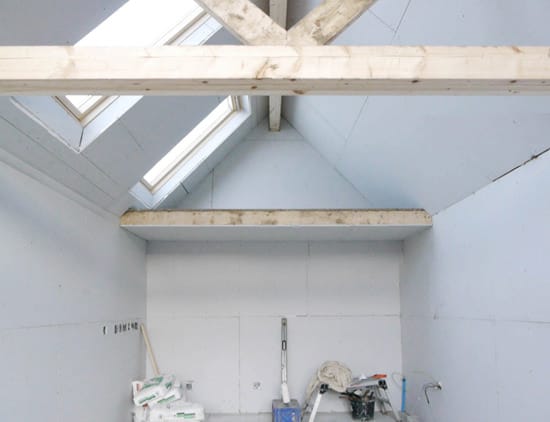
My studio halfway through the build – the side of my studio is North facing so I've installed iii large Velux ceiling windows on a pitched roof
This gives me a dainty spread of natural low-cal if I'm working with the window calorie-free directly backside me or to the left side of me as I'thou right handed so the canvass is always illuminated, similar to the position of the easel in the Rembrandt studio below.
If you have a large North facing window that is low (similar Cezanne's window light in his studio above) y'all have to be enlightened of bounced light.
This is where light from exterior is coming in from the lesser of the window and so striking the top of the ceiling in the studio – reflecting light from the ceiling downwards into the space.
If you're trying to create a strong directional calorie-free result, the reflected light from the ceiling tin can lessen the strong contrast, also, if you have whatever colour on the ceiling this will exist reflected into your studio.
You just need to add a 'hood' over the pinnacle of the window to stop the lite spilling up into the ceiling.
It's like adding a barn door to a photography studio calorie-free – you lot're simply controlling the low-cal coming into the infinite.
Depending on where you lot live in the earth, the intensity of the light will vary, and so a bright summers day in Italy, volition be much more intense than a summers day in the United kingdom of great britain and northern ireland.
Impressionistic or Classical?
If you pigment in a more than Impressionistic mode, similar Cezanne, reflected light can add to your set up, illumination of the space is your number one priority.
However, if you are only going to exist creating highly dramatic, Chiaroscuro Old Master style lighting, then reflected light can pose problems.
You can get completely black in the studio, black walls, black ceilings, blackness floor, blackness dress! but if you don't manage reflected calorie-free and then it tin can defeat the whole object of creating a space lit with one single light source.
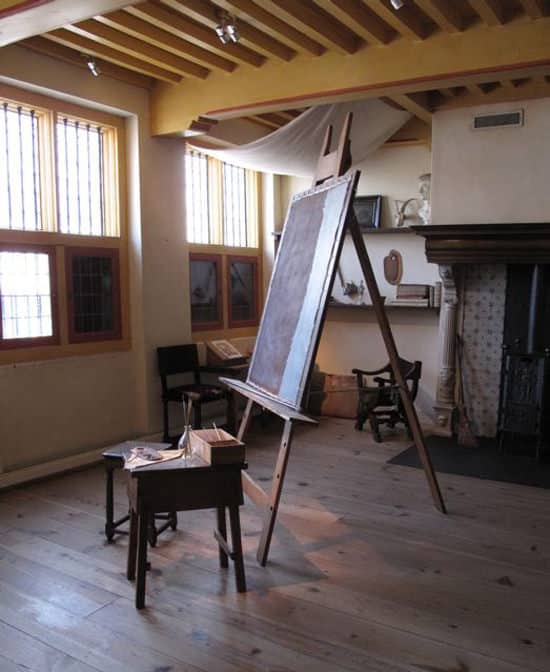
Rembrandt's Art Studio lighting – Look at the low blackout windows and the canvas hood that prevents the light bouncing on the ceiling. You tin can read about my visit to Rembrandt's studio here.
So, if you have a large low window, generally the bottom half should exist covered with diffuser fabric then y'all go only low-cal coming into your studio higher upwards, helping to illuminate your canvas without casting shadows.
Blackness out roller blinds tin can be very helpful in controlling the intensity of the light, the smaller and higher the calorie-free source, the more one-half tones you encounter in the subject.
Now nosotros brainstorm to enter the realms of artificial lighting.
What is colour temperature?
Have you ever seen a chameleon modify colour?
Well, this is how low-cal changes throughout the day, depending on the time of year, conditions, and if you're in the Northern or Southern hemisphere.
Just as different paint colours are called warm and cool, so are unlike lite sources. And this can issue how yous perceive colours in your studio.
With natural daylight, the changes happen subtly throughout the day, so initial colour change isn't always apparent. Even so, when you're concentrating and trying to paint a discipline, yous are battling against the perceived colours that keep irresolute!
This is why in Monet'southward Haystack series he worked on numerous canvases equally every couple of hours the light changed.
I overcome this in my studio by painting under a combination of natural and bogus light. For these to marry together we demand to aware of the range of colour temperature of bulbs (frequently referred to by electricians every bit lamps)
Colour temperature
The colour temperature of lamps are measured on the Kelvin (K) scale, so you can say 'what Kelvin are those lamps?' and sound super clever!
Information technology'south called colour temperature because the scale originated from heating up Carbon to extremely high temperatures and the different temperatures produce a different color.
If you were to heat carbon to 2426.85 degrees Celsius it would take a Kelvin of 2700K, and would glow yellow-white.
If y'all heated carbon to 5126.85 degrees Celsius it would have a Kelvin of 5400K, and would glow bluish-white.
So the higher up the Kelvin calibration (colour temperature) we go, the cooler and more blue the light.
And then a lamp with a Kelvin of 6500K would be called a absurd light.
So how does this relate to Due north light?
The kelvin of north calorie-free
The most common colour temperatures of low-cal are every bit follows:
- A regular household incandescent bulb – 2,500K – 3000K and gives a nice warm light
- Part fluorescent light – 4,000K – 5000K and gives a cleaner, cooler light
- Noon Daylight – 5,500 Yard
- North Light (blueish heaven) – 7,500K -ten,000K
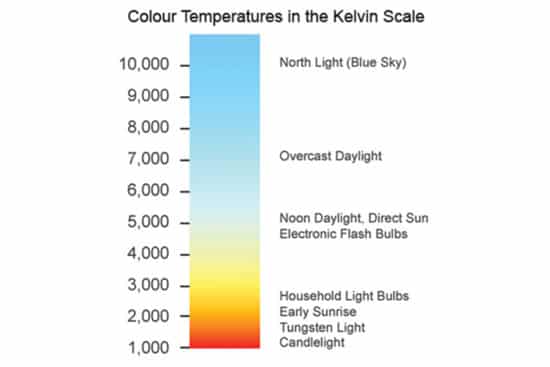
Due north light varies depending on if you live in the Northern or Southern Hemisphere, but in full general North calorie-free/ blue heaven is around 7, 500 – 10,000 Kelvin and if you lot were to mimic this is a lamp would exist far too blue/cool to paint with.
In my studio, because I need bogus light as well as natural low-cal I aim for a lamp of between 5000K – 5500K, this gives a white calorie-free rather than information technology having a cast of existence too blue or too orange.
But simply relying on Kelvin isn't the merely consideration, it'due south number 1 on your tick list but you lot could buy a cheap bulb with a 5000K but if it hasn't got a full spectral range, referred to in the industry as a CRI rating, and then information technology might not exist as accurate as you think.
CRI (pronounced 'cree' not C.R.I like F.B.I as I commencement thought!) stands for Color Rendering Alphabetize.
This is the power of a light source to render a full spectrum of colours to our optics.
Colour rendering index CRI
So, the next thing nosotros take to consider when choosing a lamp is the colour-rendering index (CRI), this indicates a low-cal's ability to illuminate color accurately.
Natural daylight has a CRI rating of 100, this is what ideally we're aiming to mimic in a lamp.
The more counterbalanced the rendering results are, the higher the CRI volition be.
Pro tip: 'Total spectrum lighting' is a phrase used by the lighting manufacture to denote bulbs that mimic the properties of sunlight, but some bulbs/lamps described this way perform improve than others. So for example, y'all could have an artificial low-cal source that renders dejection and reds accurately merely doesn't have a strong yellow in its spectral curve then the rendering of the xanthous will exist duller.
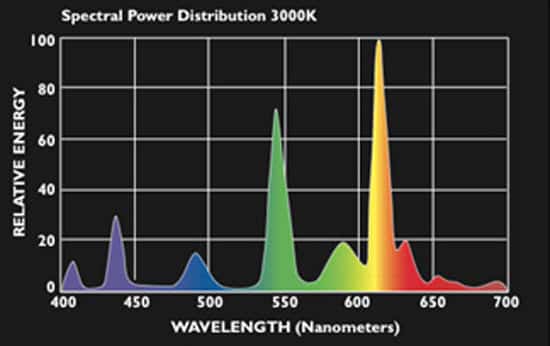
Here you tin can run into this has a very spiky, spectral bend, so doesn't offer an even colour rendering.
Colour is created by the selective reflection and absorption of the colours in the visible spectrum by the painting'due south pigments.
This is actually important for the lighting in your studio so you lot tin can mix a full range of colours accurately.
The higher the CRI score (out of 100) the more than accurate to a full spectrum color, the light source. Bulbs with a CRI of lxxx to 100 are best at revealing vibrant, natural hues.
With bogus light, we're looking for a calorie-free source that is ideally over 90 and as shut to 100 every bit possible. Unlike lamps take different colour rendering indexes. This indicates how shine, or how 'spiky' the light source is. If the source has spikes in it or is not well balanced you get an illumination that has flat rendition of some colours.
Just every bit a notation, the highest CRI rating lighting manufacturers produce with a 5000K – 5500K is currently effectually 98.
Pro tip: The correlated colour temperature (CCT), measured in Kelvin, refers to how warm or cool a lite appears. Too warm a bulb may tint work scarlet xanthous, whereas besides cool a light can turn things blue. For a good residue of warmth and coolness, wait for bulbs with a CCT of 5500 K, the equivalent of midday dominicus. If you prefer libation light, akin to north light, look for bulbs rated 6500 M.
Lumens, lux & lite output
And finally just very chiefly the next (and about final) matter to consider is luminosity or brightness.
This is different to Kelvin or CRI, this is the lamps lumen rating or wattage rating.
Calorie-free measurement
Light measurement is complex. It is difficult to compare products when manufacturers provide operation in different formats. Wattage is the measure of how much electrical power a calorie-free source uses, not how bright it is. For a true comparison of output, lumen is the best measure to use.
The lumen is the measure out of luminous power of a light source every bit perceived past the human centre. Lumens draw how much light in full is emitted from a light source.
What are lumens?
Watts measure out the amount of energy required to light products, whereas lumens mensurate the amount of light produced.
The more than lumens in a light bulb, the brighter the calorie-free.
Using lumens helps y'all to work out how vivid the space will be, regardless of the type of lamp y'all are using.
For example: Yous could take a LED down-low-cal, a Meaty Fluorescent Lamp and an Incandescent seedling that all have unlike wattage per bulb just by using Lumens you can piece of work out the calorie-free output produced.
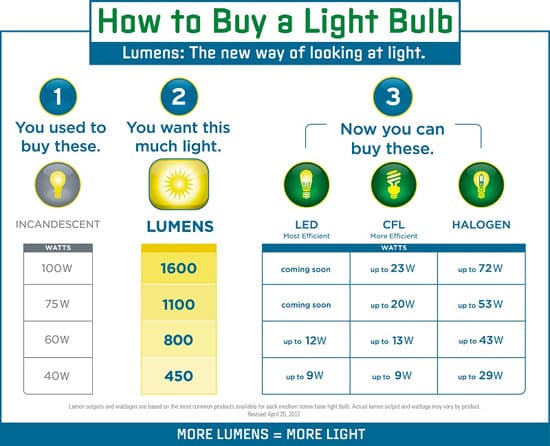
- xl-watt incandescent seedling = 450 lumens
- 29-watt Halogen = 450 lumens
- 9-watt LED = 450 lumens
- ix-watt Compact Fluorescent Lamp = 450 lumens
And then to clarify, by and large, total calorie-free output from a lite source, regardless of the management the light travels, is specified inlumens (lm).
So tin can I just observe a handy lumen comparison chart to see how many lamps I need for my studio space?
You would retrieve!
Just in that location are so many variables that there isn't a one size fits all and to complicate it further to depict the amount of light that hits a specific surface eg: your canvas, some other term is used chosen Lux or Footcandle depending if yous work in meters or anxiety.
Lux is defined as the level of brightness at a item distance from the light source.
Then the further from the lite source the less the Lux level.
The formulas for measuring how much brightness you will need in your space are complicated, I constitute trying to work out calorie-free fallout, ceiling height, diffusers on lamps, beam spread etc.. actually difficult to calculate!
Simplest solution
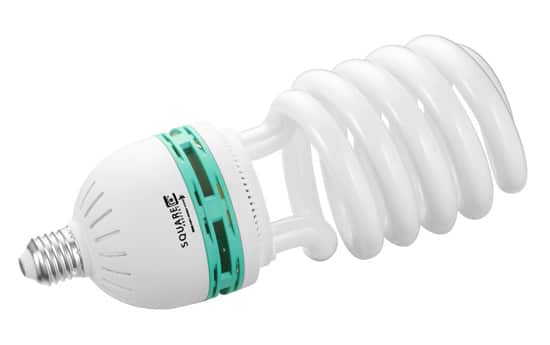
My peak tip for lighting a minor fine art studio with a ceiling tiptop of viii – 10 foot, is a bulb you can just spiral into your existing plumbing fixtures and is a Meaty Fluorescent Bulb.
It should have a 90+ CRI rating, 5000K- 5500K color temperature and around 85 watts, it will give a light output of around 5000 lumens at the lamps source and volition requite you a bright, clean light to piece of work under.
Pro Tip: The lite force diminishes as the light is moved further from the source and so past the time it hits your canvas it would probably exist a 2/iii of the strength, effectually 1,800 lux – based on you sitting 1.5 meters away from the lamp in the ceiling.
The recommended lux level for detailed drawing work or very detailed mechanical work is 1500 – 2000 lux and so this would fit the pecker! Hurray!
However, 1500 lux is still very bright and I would imagine for nearly home studio situations, this seedling would requite out ample illumination.
For many classical paintings, a lux level of 250 – 450 lux can yet work very well, especially if your finished slice is going to be hanging in a darker space.
The lux value changes depending on how far away from the source you are painting, the bending of the axle etc.. but this lux calculator is very handy if you lot desire to cheque your ain studio and find a light level that works best for the style of work and blazon of paintings y'all are going to be creating.
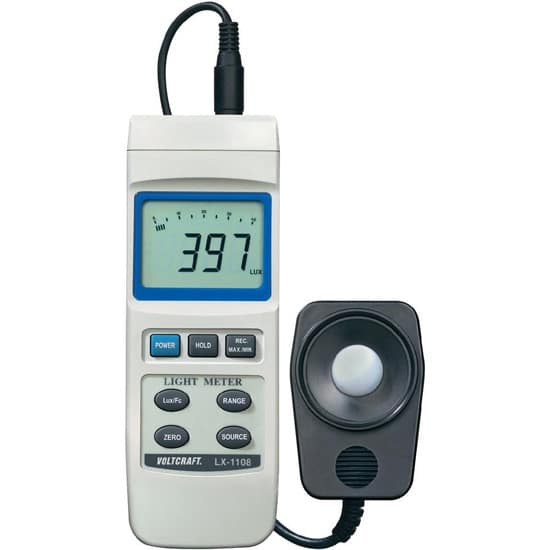
Lux can be measured by a Lux meter if y'all want to become super pro
A brief lamp overview
Hither's my overview of lighting and how to cull the all-time solution for your own infinite.
Incandescent Household Lamp
These are very inexpensive, have a high CRI rating 95+ but are a very warm light resulting in you really painting things cooler than you would like, not the all-time choice for an art studio. Incandescent low-cal bulbs are being phased out in favour of more free energy-efficient lighting.
Compact Fluorescent Lamp (CFL)
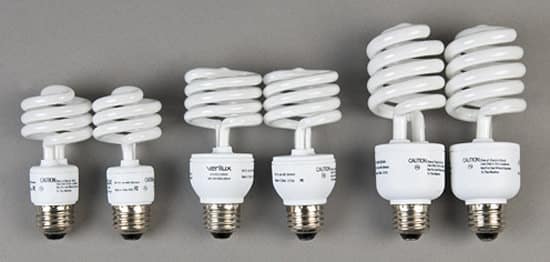
A compact fluorescent lamp (CFL) is a blazon of fluorescent lamp. Many CFLs are designed to replace an incandescent lamp and can fit into most existing low-cal fixtures formerly used for incandescent light bulbs but generally apply less ability, have a longer rated life and give the same amount of lite, merely at a higher purchase price.
They more often than not have a lower CRI rating of 80 + (you tin find odd ones that are higher) but Kelvin can exist 5000K – 5500K.
CFLs radiate a dissimilar light spectrum from that of incandescent lamps, but are condign more like in colour output to the standard incandescent light seedling.
Halogen Lamp
A element of group vii lamp consists of a tungsten filament sealed in a compact transparent envelope filled with an inert gas and a small amount of halogen such every bit iodine or bromine. The element of group vii iodine or bromine increases the lifetime and the luminous efficiency of the lamp. Element of group vii lamps attain a luminous efficiency of approximately 25 lumens per watt (a conventional incandescent light seedling is approximately 15 lumens per watt and a meaty fluorescent lamp is approximately sixty lumens per watt).
Halogen bulbs are smaller than conventional lite bulbs and unremarkably found in recessed chore lighting, CRI is high simply colour temperature is normally very warm.
Full Spectrum Halogen Lamps
Want to calorie-free your painting similar the Mona Lisa?
Then y'all need to invest in some Solux bulbs.
These bad boys are used in museums globally, such as The Louvre in Paris, Guggenheim Museum, NY & The Van Gogh Museum to name a few. The CRI rating and spectral curve is amazing and for artificial lighting that best illuminates natural daylight, y'all tin't get much better.
So, have we found the perfect solution?
It depends.
If yous work pocket-size and accept a friendly electrician these can be a nifty solution, in that location is a four lamp track available that gives a great value spread light, however, the halogen light has a spot consequence, rather than bringing upwardly the illumination of the room.
And so for lighting the Mona Lisa, perfect.
For creating an ambient light in your studio?
Harder to achieve.
The lights are often used for photography proofing of colours, so take been designed on a track organization for illuminating a wall.
The halogens also run hotter than the fluorescent'due south and apply a affect more than free energy. Besides they are harder to rails downwards in the U.K.
Solux bulbs are the best halogens on the market, just they are expensive compared to lifespan/ price ratio of fluorescent bulbs.
Pro Tip: They produce an amazing reading lamp for a lovely quality of lite.
Full Spectrum Fluorescent Tubes
These tubes are probably the side by side best thing indoors to North light for most artists wanting a proficient illumination of the whole infinite.
They are relatively cheap and efficient and have good color indexes on the more than expensive tubes.
The light source of a fluorescent tube is mercury and the lite that mercury produces gives of 'spiky' lightwaves, the light isn't an even spectral curve.
To combat this, manufacturers coat the inside of fluorescent tubes with a phosphor coating.
The phosphor coating helps to smooth out the spiky low-cal wavelengths and gives a more even spread of colours.
So for lighting an artist studio we're looking for a tube with a 'tri-phosphor' coating.
Skilful quality 'triphosphor fluorescent's use three phosphors to give off red, green and blue low-cal. This tricks your eyes into thinking they are seeing white, in much the same manner as a Telly screen works.
Specialist fluorescent's are available with a CRI higher than 90%, merely these are slightly less efficient and are unremarkably merely used past professionals such as graphic designers or artists.
I will be using full spectrum fluorescent's to lite my studio, the lamps I'm going to go for are Philips TL-D 90 Graphica Pro Triphosphor 4′ T8 36 Watt Fluorescent Tube 36W,
They accept a Kelvin of 5300K and a CRI of 98 and I tin create a bank of lights to mimic diffused daylight whilst ensuring the lux level is going to exist high plenty.
On a happy notation, as the bulb mimics natural daylight information technology's ideal for sufferers of Seasonally Affected Disorder or S.A.D, so gives a feel-expert factor whilst yous work!
A note on fluorescent lamps
In fluorescent tubes, in that location is a number that represents the diameter of the tube.
The tubes I'chiliad using are chosen a T8 and the industry are in the process of phasing them out, along with the T12 in favour of more than energy efficient bulbs.
The T5 and LED'due south are the alternatives but I've yet to find either that offering a loftier enough CRI rating, however, I believe over the side by side couple of years with developments in manufacturing there will be a more energy efficient like for like replacement.
Phew! hope it helps with setting upwards your art studio space.
Source: https://willkempartschool.com/art-studio-lighting-design/
0 Response to "For an Art Studio Is Light Best From the North South East or West"
ارسال یک نظر